Upgrade your bed right now: choose the best mattress topper with my complete guide to what to buy, from the best brands
I, along with our sleep team, have ranked and reviewed dozens of mattress toppers from Saatva, Tempur-Pedic, Helix, and more – but which should you buy to make your bed more comfortable? My guide tells you everything you need to know
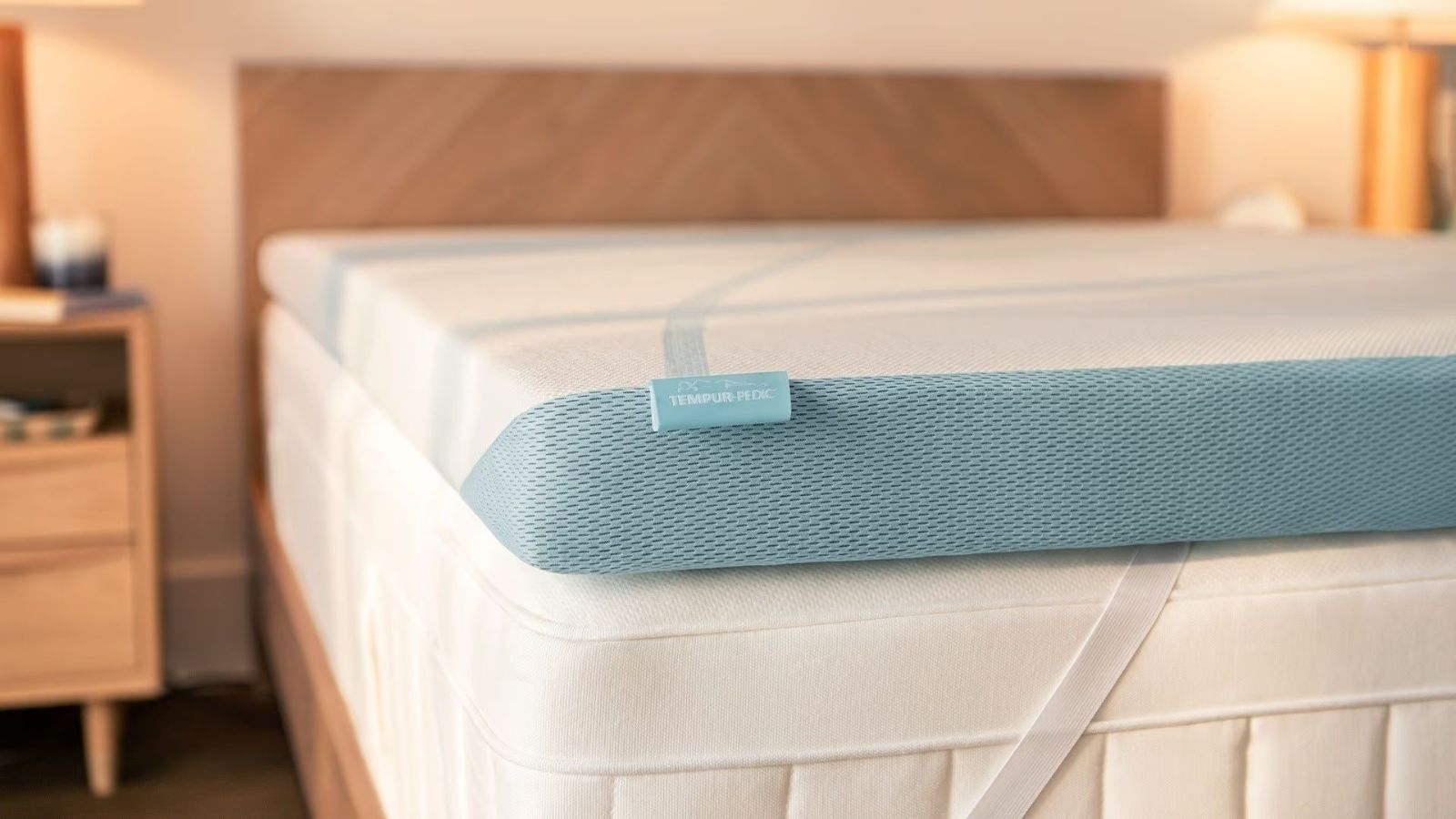

Sarah Warwick
If your bed isn’t as comfortable as it used to be, or you’re looking for extra softness, cooling, or support, a mattress topper could be the ideal solution – at the fraction of the price of a brand new mattress.
In this guide, I will help you decide whether a topper is right for you, and which to buy – or whether it makes more sense to invest in a brand-new mattress.
As Sleep Editor at Homes & Gardens, I lead a team of expert testers across America. Cumulatively, we've spent years testing for pressure relief, thermoregulation, motion isolation, and edge support on foam, feather, and latex mattress toppers in the search of the world's best.
We represent a wide range of sleep styles, ages, and body types, and sleep on each topper for eight hours a night, seven nights a week, for a minimum of 30 nights before we write our reviews (yes, we're paid quite literally for sleeping), so we really do understand the pros and cons of all the different mattress topper types.
Our reigning champion is the Tempur-Adapt Tempur-Topper, which combines the contouring comfort and motion isolation of memory foam with a cooling cover for enhanced thermoregulation – but you might prefer one of our tested alternatives, below.
I'll start, though, with a need-to-know guide for newbies to mattress toppers.
Why buy a mattress topper – what does it do?
A mattress topper can:
- Add comfort, making a firm mattress feel softer or a slightly uncomfortable mattress more plush (think mattress toppers for dorm beds!). It provides extra cushioning for pressure points (shoulders, hips, back) – from my research, I know that putting on or losing weight, being pregnant, experiencing menopausal symptoms, or simply over-doing it at the gym can make your existing mattress suddenly uncomfortable.
- Improve support (to some extent) – memory foam or latex toppers can help align your spine better, but only if the underlying mattress is not extremely saggy (see below for what a mattress topper can't do).
- Regulate temperature – some mattress toppers are designed to help regulate body temperature: gel-infused memory foam, breathable materials are used for cooling mattress toppers (for summer or hot sleepers), or wool and feather-filled fillings for winter or sleepers who like to be snug.
- Protect your mattress – mattress toppers can act as a barrier against spills, dust, and allergens, though I would still advise adding a mattress protector over your mattress topper to protect that too! Both can also extend the life of your mattress by reducing wear.
- Be convenient – easier to clean or replace than a full mattress, a mattress topper is fairly lightweight and easy to transport, ideal for dorms or if you know you're going to have to endure a guest bed mattress that doesn't quite match up to your mattress at home (our Content Director Lucy Searle has admitted to visiting friends armed with her own mattress topper!).
A mattress topper can't:
- Fix a very old or sagging mattress – a mattress topper can’t replace lost support from a worn-out mattress. You might feel the dips through the topper.
- Provide long-term structural support – a mattress topper won’t make a mattress feel like a high-end, new mattress in terms of support and durability.
- Prevent all allergens or dust mites – although some toppers are hypoallergenic, they don’t make your mattress completely allergen-free; you will need to invest in a mattress protector to boost this.
- Correct serious back problems on their own – while mattress toppers can improve comfort, for chronic back pain, a proper supportive mattress is more important than a topper.
- Replace a mattress for comfort for very different body types – someone very heavy or very light might still find the underlying mattress uncomfortable despite a topper.
Mattress topper vs alternatives: what do you actually need?
Do you really need a mattress topper? Or would a pad, protector or even a new mattress be better? Here, I'll tell you exactly what the benefits of mattress toppers are, and when an alternative is better.
Mattress toppers vs mattress pads
Mattress toppers are thick layers (usually 2 to 4 inches) designed to change the feel of your bed – adding softness, firmness, or cooling. Choose a topper if you want to adjust how your mattress feels.
Mattress pads are thinner, quilted layers that provide light cushioning and protection, but won’t dramatically alter comfort or support. Choose a pad if you mainly want to protect your mattress or add a touch of plushness. Amazon sells a wide range of top-rated mattress pads that are worth looking into.
Mattress toppers vs mattress protectors
Mattress toppers modify the feel of your bed, as I said above.
Mattress protectors shield your mattress from spills, dust, and allergens, but don’t change comfort.
In most cases, you’ll use both: a topper for comfort, with a protector over the top to keep everything clean.
Mattress toppers vs new mattress
Mattress toppers add comfort if your bed is too firm, provide temporary support, offer cooling or motion isolation. They cannot fix sagging, lumps, or lost support.
A new mattress will be the only fix for the problems I've mentioned above. If your mattress is more than seven to 10 years old, or leaving you sore, a new mattress is the better investment.
Mattress topper materials, firmness and your sleep
Each topper material feels different to sleep on: some are more breathable, some are firmer than others. Here's a bit more of a breakdown:
Firmness first: your sleep position – whether you lie on your front, back, or side − is, in my opinion, the most important factor, because that impacts your spinal alignment and informs what type of mattress topper will feel best for you.
As a general rule, side sleepers need a softer surface to cushion their joints while supporting their hips to keep their spine straight. Back sleepers tend to appreciate a medium-firm topper to stop their hips from sinking into the surface of the mattress, while stomach sleepers need a firm topper to keep their hips in line with their chest.
Brands generally rate firmness on a scale of 1 to 10, where 1 is super-soft and 10 is ultra-firm, but it's not entirely consistent across the industry.
Sleep temperature: if you suffer from hot flashes or night sweats, or you live in a warm climate, then you need one of the best cooling mattress toppers (or pads) to regulate your temperature. As a general rule, I recommend natural materials, such as latex, for their breathability, although some memory foam models incorporate phase change materials for active cooling.
Best mattress topper – 6 best-on-test, by type
We have tested dozens of toppers over the past couple of years. Below, you'll find a bite-size summary of each topper type we have rated most highly, including who it suits and how it feels.
Make sure to use my mattress jargon buster (below) to define any unfamiliar terms.
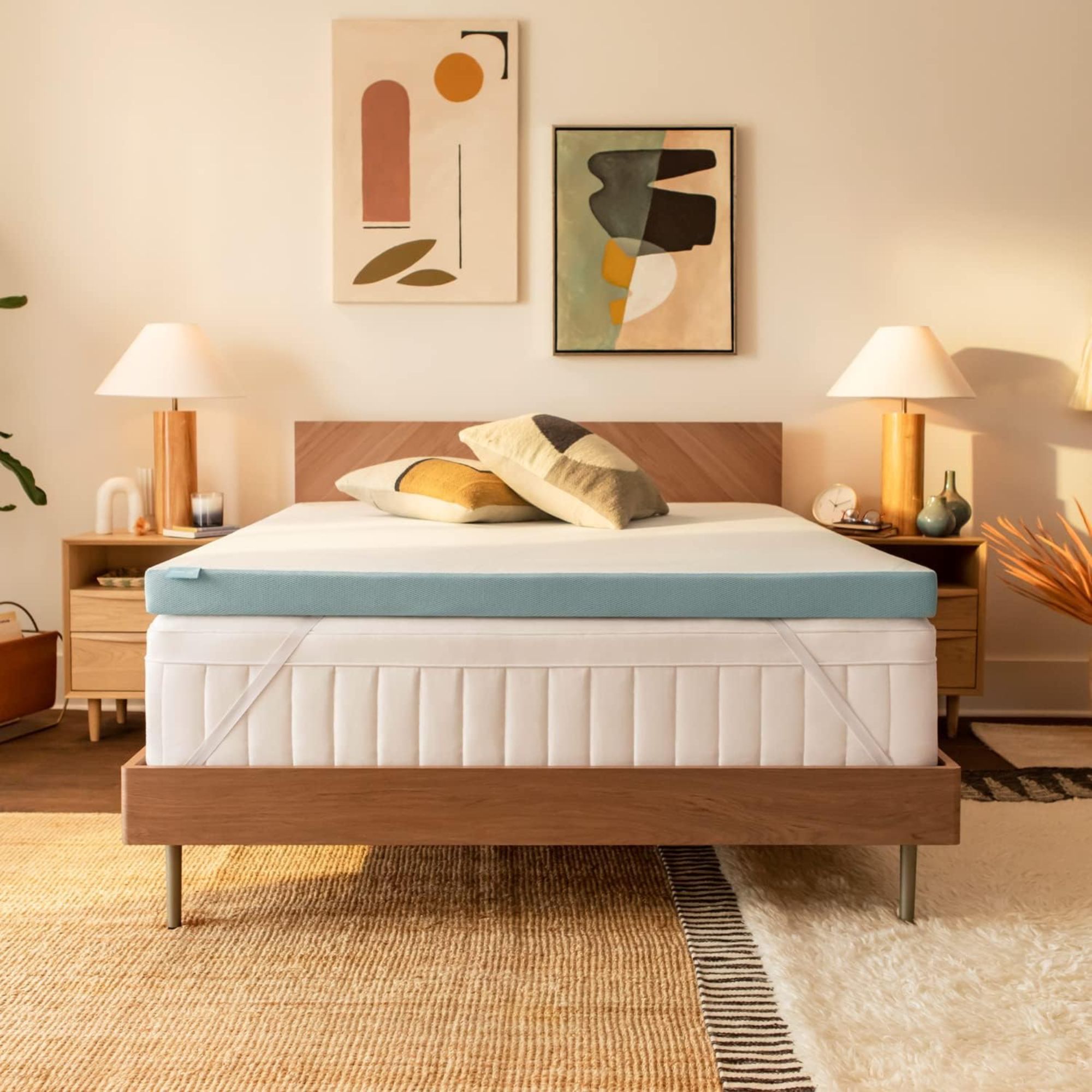
Firmness: Medium
Ideal for sleepers who want consistent comfort in any bed, the Tempur-Adapt Tempur-Topper (memory foam) is excellent for pressure relief, thermoregulation, motion isolation, and edge support; it's also often discounted.
'As a side sleeper, I immediately noticed a difference between the Tempur-Adapt Tempur-Topper and other memory foam models I've tried in the past,' says our expert tester Alexandra Pamias, who has been sleeping on hers since 2022.
'I felt like I was sleeping on top of the topper, rather than sinking into it. The memory foam contoured around my curves to bear my weight, keeping my hips and knees from sinking too far beneath my neck and shoulders. I felt like my spine was in perfect alignment.'
Alexandra's deep Tempur-Adapt Tempur-Topper review tells you more
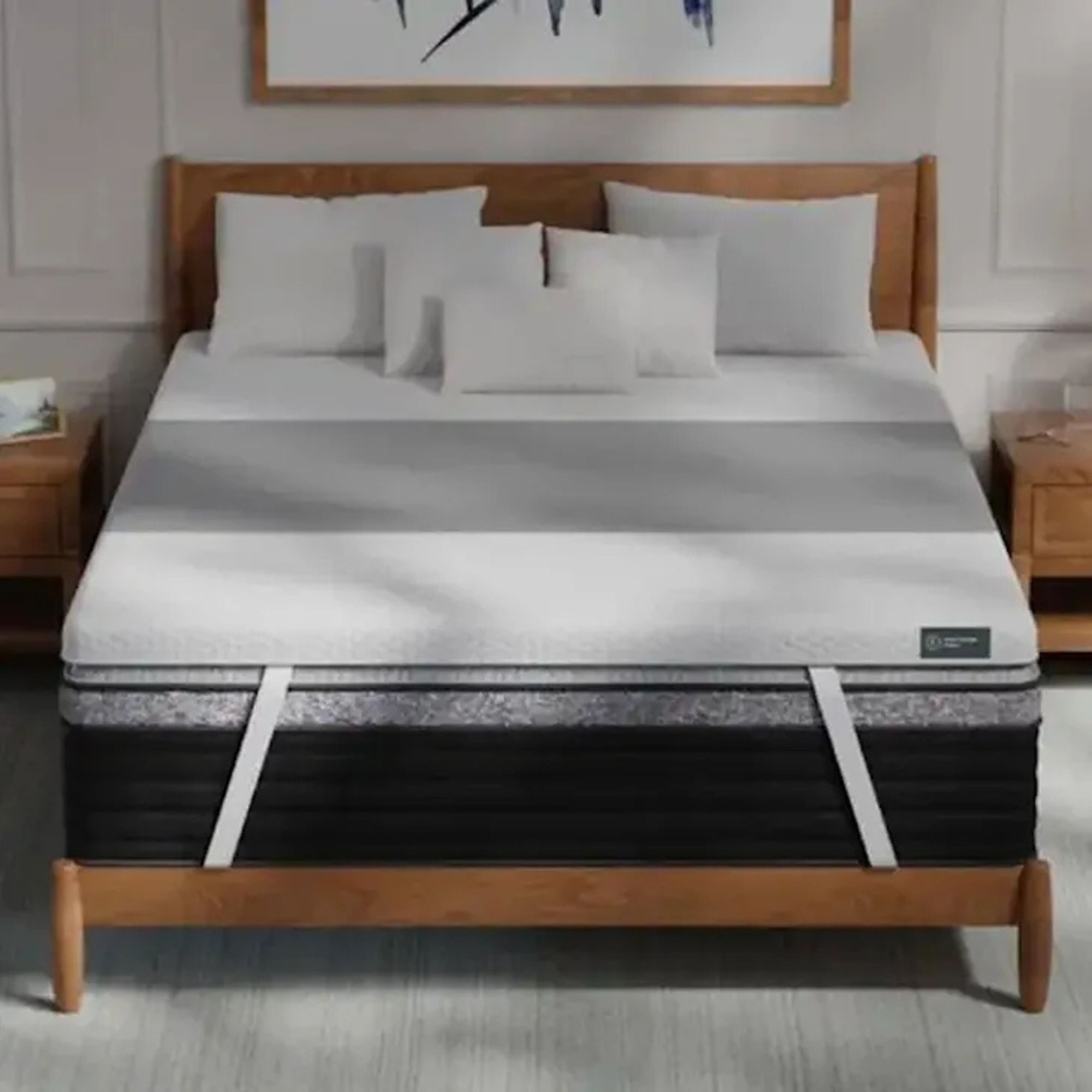
Firmness: Medium-firm
This mattress topper is ergonomically designed to support your spine and lift your lumbar region while allowing your shoulders, hips, knees, and ankles to sink into the surface.
'This topper has three different firmness zones, with the firmest section in the middle for optimum lumbar support,' says expert tester Meg St-Esprit. 'It’s a great option to upgrade a subpar mattress for sleepers with back issues.'
Meg likes almost everything about the Helix ErgoAlign Mattress Topper, from the cooling cover to enhance breathability to the stretchy corner straps that keep your mattress topper from sliding. It's one of the more expensive toppers on our list, but you will be able to save some money in the mattress sales.
Meg's Helix ErgoAlign Mattress Topper review goes into greater detail

Firmness: Medium-firm
Old-fashioned memory foam used to trap heat, but modern designs are breathable. The Saatva Graphite Memory Foam Mattress Topper is infused with cooling graphite to dissipate heat, wick moisture and block odors, making it great for hot sleepers and summer nights.
'I started testing the Saatva Graphite Mattress Topper in the middle of the hottest summer New England has ever seen, so I can confirm it lives up to those cooling claims,' says expert tester Kaitlin Madden.
'On a firmness scale of 1 to 10, where 1 is super-soft and 10 is ultra-supportive, I'd rate the Saatva Graphite Mattress Topper around a 5 or a 6,' says Kaitlin. 'If you know you need a firm surface, I suggest the Nolah Mattress Topper (below), instead.
Kaitlin's Saatva Graphite Mattress Topper review gives you the full download
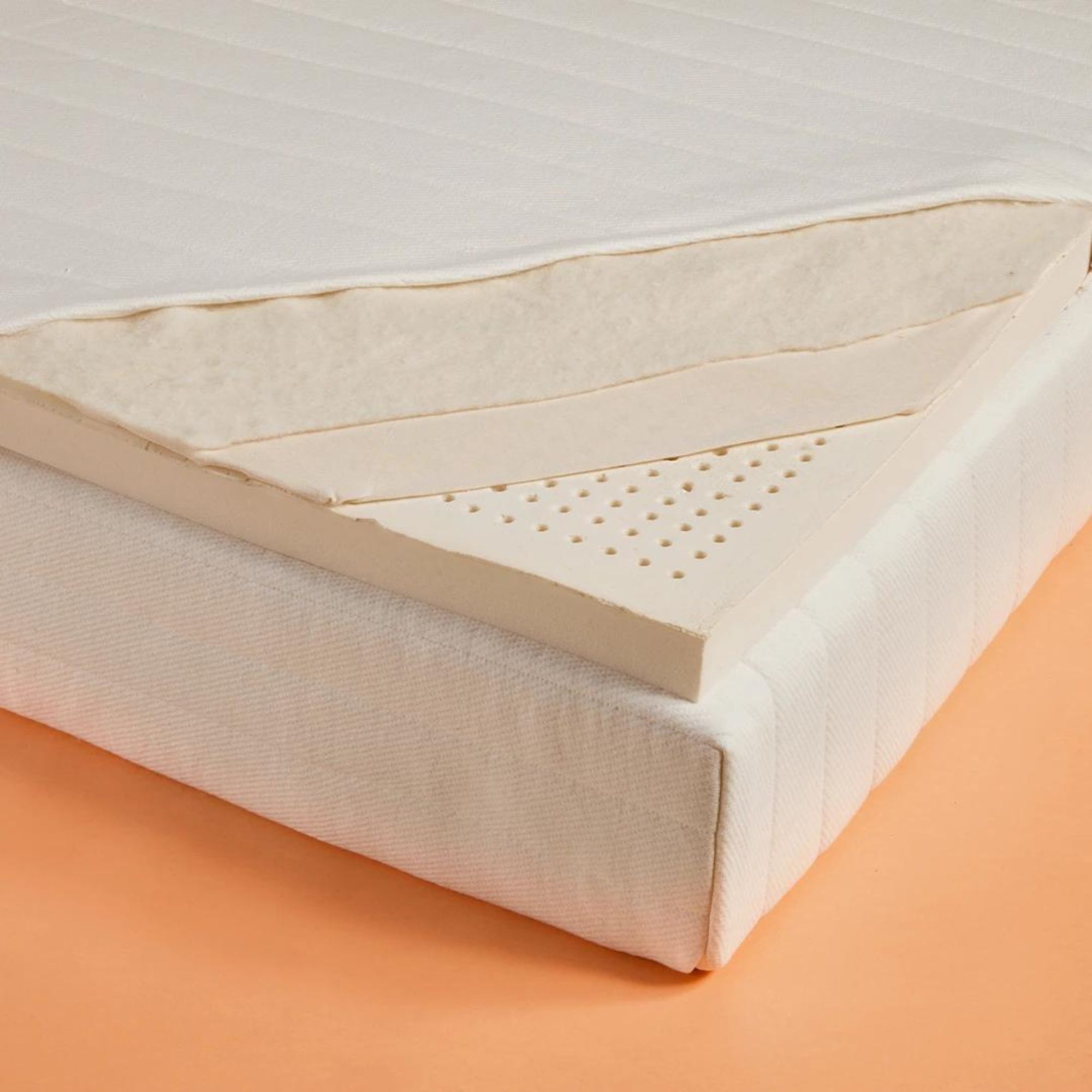
Firmness: Medium-firm
Filled with GOTS-certified organic Dunlop latex, this Fair for Life-certified mattress topper feels responsive and supportive. It's firm enough to lift your pelvis and keep your spine straight, yet soft enough to cushion your hips, ankles, knees, and shoulders.
'I started sleeping on the Earthfoam Mattress Topper back in spring 2023,' says expert tester Louise Oliphant. 'While the latex core offers springy support, the comfort layers of organic wool and cotton contoured around my curves to take the pressure off my joints.
'Unlike dense memory foam, latex has an open-cell structure with plenty of air pockets to boost breathability throughout the bed. Just a few nights into testing, I was falling asleep faster and waking up without any of my usual aches.'
Louise's Earthfoam Mattress Topper review tells you much, much more
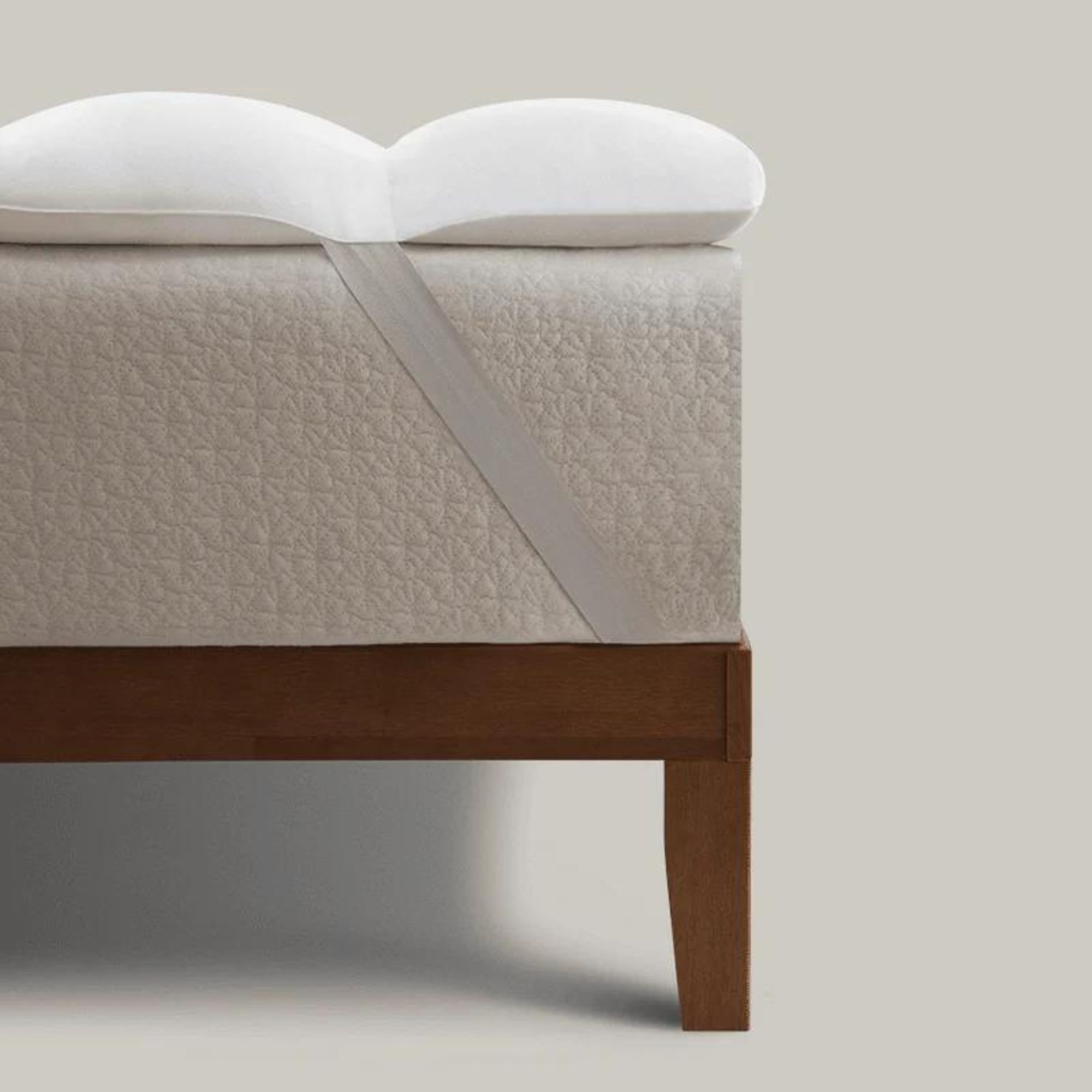
Firmness: Medium-soft
This five-inch pillowtop is filled with cross-cut memory foam, spun into super-soft fibers for plush comfort. I'd recommend this mattress topper for anyone who wants to bring hotel-quality comfort to their home mattress.
Right before she started testing the Earthfoam Mattress Topper (above), Louise was sleeping on the Coop Retreat Mattress Topper. Where the Earthfoam feels firm, the Coop feels soft and squishy.
'Memory foam is made to cushion your joints and bear your weight to relieve pain,' explains Louise. 'Where a firmer surface might apply more pressure to the affected area, the Coop Retreat Mattress Topper acts as a pillow. I typically suffer from knee pain, but I noticed the foam cushioned my body and cradled by joints.'
You can find out more in Louise's deep review of the Coop Retreat Mattress Topper
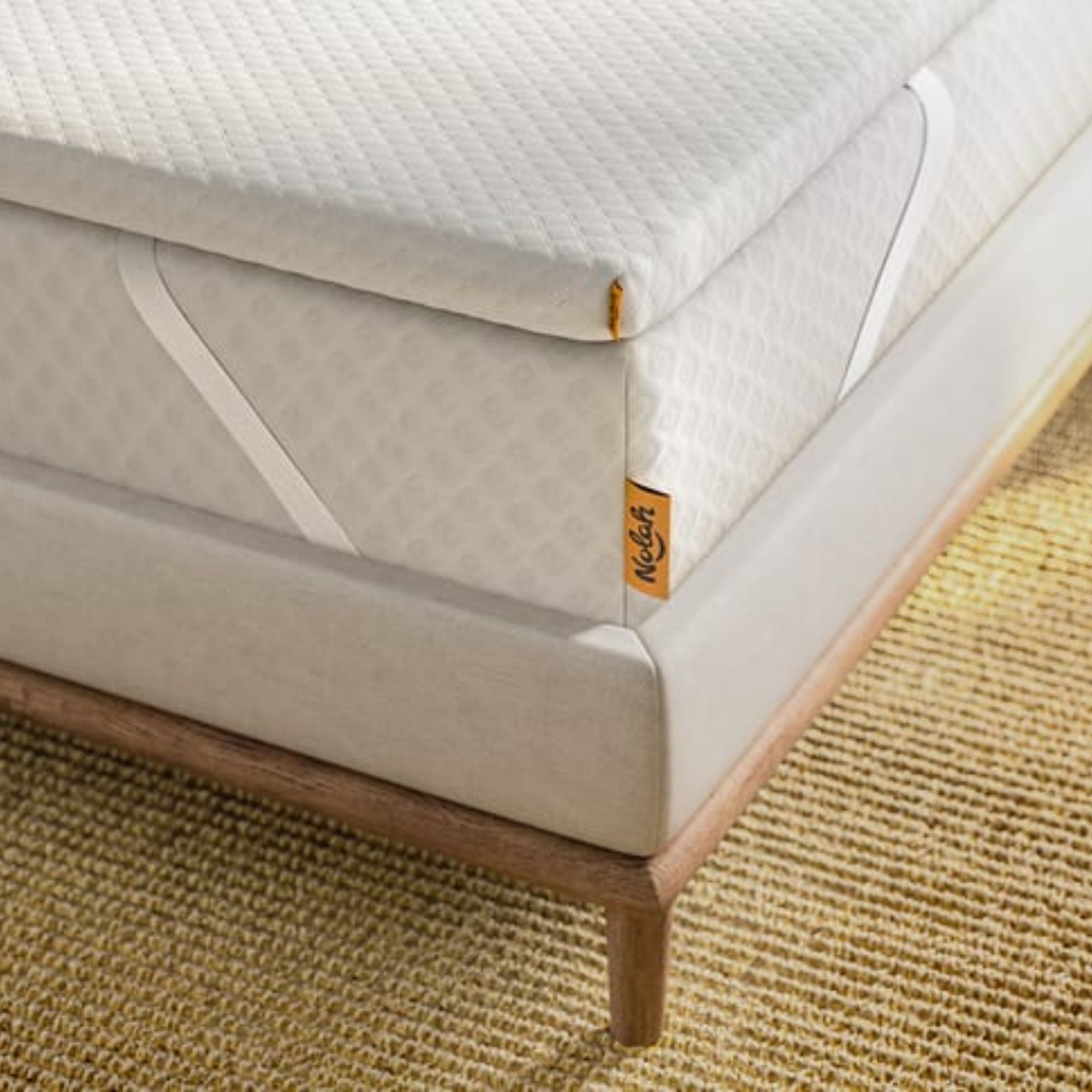
Firmness: Firm
Despite what we've said about mattress toppers not being able to fix a sagging mattress, filled with high-density memory foam, the Nolah Mattress Topper is able to do that to a degree.
Expert tester Jamie Davis Smith bought a new bed a few years back. She appreciated the soft support, but her husband was waking up in agony. 'That's where the Nolah Mattress Topper comes in. Since we started testing, my husband says his back pain has completely disappeared, which is proof it was never a musculoskeletal issue, but a too-soft mattress issue.'
The Nolah Mattress Topper is strategically perforated to boost breathability. 'As a woman of a certain age, I've suffered from night sweats and hot flashes, but I didn't have any thermoregulatory issues,' says Jamie.
Jamie's Nolah Mattress Topper review goes into greater detail
Best mattress topper brands
The best mattress topper brands are, as above: Tempur-Pedic; Helix; Saatva; Earthfoam; Coop and Nolah.
Many of these can also be bought from Amazon, which has its own list of best mattress toppers, built on reader reviews, among other measures.
I would also recommend shopping tried-and-trusted retailers, such as Macy's and Wayfair.
FAQs
When to buy a mattress topper?
As a Sleep Editor, I'm often asked when to buy a mattress topper. My answer depends on the current state of your mattress: how long you've had it and what condition it's in.
If you've had your mattress for a long time – upwards of seven years − and you can feel the foam deforming and the coils creaking, then it might be time to replace your mattress. Even the best topper can't stop time or fix the structural issues inside your mattress.
If you've only had your mattress for a few years or less, but you can't get comfortable, then a mattress topper might be able to change the look and feel of your bed. To work out what sort of topper you need, lie down on your mattress and settle into your usual sleep position. If you feel like you're sinking through the mattress, and your spine is starting to curve, that's a sure-fire sign that your mattress is too soft. If you feel like your hips and shoulders are getting crushed against the surface of the mattress, then it might be that your mattress is too firm.
What size mattress topper should I buy?
Your mattress topper size should match that of your mattress exactly, whether twin, full, queen or king. Look for fitted covers or straps to prevent slipping; you can also buy straps and fittings for mattress toppers on Amazon to stop them shifting as you move in your sleep.
How thick should my mattress topper be?
The thicker the mattress topper, the greater the comfort level, though the firmness (or softness) of the mattress beneath will affect how the mattress topper feels. As a rough guide:
2 inch-thick mattress toppers offer subtle comfort, good for slightly firm beds.
3 inch-thick mattress toppers offer a noticeable change in comfort, balances support and softness.
4 inch+-mattress toppers offer a significant comfort boost, ideal for very firm beds or side sleepers.
How do I clean a mattress topper?
My best advice is to clean a mattress topper (we have a dedicated guide, by the way, which you can access via the link) according to the manufacturer's instructions, though if yours has a removable cover, which many foam and fiberfill toppers do, they can be simply put in the washer.
Note, though, that in my experience, it's not always easy getting them back on. Best advice? Invest in a mattress protector for your topper, which will make it much easier to care for. Other than that, rotate the topper regularly to ensure wear (and spills) are even.
How long does a mattress topper last?
A mattress topper lasts three to five years on average; foam and latex are the most durable.
Can a mattress topper fix a bad mattress?
A mattress topper cannot fix a bad mattress, unless by "bad" you mean "too firm". Mattress toppers are designed to make your existing mattress softer, more plush, more forgiving. They can help extend the life of a mattress, but if it is sagging or lumpy, you are likely to still feel that through the topper, especially the thinner ones.
Can a mattress topper fix back pain?
I asked Dr. Clayton Skaggs, a chiropractor with the Central Institute for Human Performance, what makes a good mattress topper for back pain. First, he clarifies that 'a good mattress or type of bed can rarely speed the recovery or resolve someone with back pain. But a poor or undesirable bed or mattress can sure slow the recovery down. The best support for the spine is a firm mattress with a soft top cover.'
That soft top cover can, of course, be a mattress topper atop your perhaps too-firm existing mattress.
'Your spine has a natural S-curve that is ideally maintained day and night,' says Dr. Thomas Pontinen, pain expert and co-founder of Chicago's largest pain center, MAPS. 'Back pain can rapidly devolve if you're sleeping in a non-neutral spinal position, especially if there are other factors at play, like an injury or chronic pain.'
Dr Thomas says that 'proper spinal alignment will depend on your sleep position. While lying on on your side, your hips should not sink too much or too little: same with your arms and shoulders. Ideally, the center of your chest should line up and be level with the center of your pelvis.'
I asked Dr. Sherry McAllister, President of the Foundation for Chiropractic Progress, what sorts of mattress toppers she recommends for different styles of sleepers. Dr. Sherry says:
'Back sleepers typically benefit from firmer toppers to prevent excessive sinking that can stress the joints of the spine. My research indicates that a 40mm topper is ideal.
'Side sleepers may need a softer topper to ensure support for the shoulder and hip. These are areas that can become pressure points.
'Stomach sleeping is not recommended, as it leads to reversing the lower back curve (lordosis) while sleeping. However, if you have trouble breaking the habit of stomach sleeping, best to have a firmer mattress topper to support the body in this position.'
How much does a mattress topper cost?
Mattress topper prices can vary widely, but I'd expect to spend somewhere in the region of $200 to $400, though you do find more affordable options on Amazon (just make sure you read the customer reviews before you buy).
At the other end of the scale, our expert tester Jamie Davis Smith slept on the Saatva Organic Quilted Mattress Topper, which goes for a little less than $1,000 for a Queen.
You don't need to spend anywhere near that much to get a good mattress topper, however, and even more expensive toppers can be snapped up for much less in mattress sales.
Is an organic topper worth it?
Yes, if you want eco-friendly materials, natural breathability, or chemical-free bedding, organic mattress toppers are worth it. Look for toppers made from organic, and non-toxic materials such as wool, cotton, latex and down. Any topper that contains toxic chemicals such as PFAS will not make your shopping list. We have a guide to organic mattresses and organic bedding too.
How we test mattress toppers

I lead a team of seasoned product testers across the country to rank and review mattress toppers. We test each topper for at least 30 nights before we publish our initial review. This gives the most accurate indication of future performance, while accounting for the time it takes to get used to a new topper. As Homes & Gardens' resident sleep editor, it's my job to check in with my testing team and continue to monitor the performance of each product. If I hear that a topper is starting to sag and lose support, I'll remove it from the buying guide and edit the review to reflect our findings.
We assess each mattress topper against the same criteria: pressure relief; thermoregulation; motion isolation; and edge support. The Homes & Gardens mattress topper review process is editorially independent and not influenced by third parties. To learn more about how we test mattress toppers at Homes & Gardens, consult our full, expert guide.
Cited sources
- Dr. Clayton Skaggs, a chiropractor with the Central Institute for Human Performance and author of The Power of Doing What Matters
- Dr. Thomas Pontinen, co-founder and physician with the MAPS Centers for Pain Control
- Dr. Sherry McAllister, President of the Foundation for Chiropractic Progress
- Lee Yu-Chi et al, 'Better combination of thickness and hardness of mattress topper for supine sleeping posture', International Journal of Industrial Ergonomics (July 2020)
- Fan-Zhe Low et al, 'Effects of Mattress Material on Body Pressure Profiles in Different Sleeping Postures', Journal of Chiropractic Medicine (March 2017)
- National Library of Medicine, 'In brief: How does the spine work?' (last updated May 11, 2022)
Our topper testing panel

Kaitlin is one of our freelance reviewers, whose work features in Architectural Digest, Vanity Fair, Martha Stewart Living, and more. As a short-term rental host, Kaitlin is looking for a mattress topper to suit all sleep styles and accommodate all her guests. As a hot sleeper hosting through the summer, Kaitlin needs a topper to keep herself and her guests cool.

Louise is our former Sleep Editor. In her time at Homes & Gardens, she tested all manner of mattresses, toppers, pillows, and bedding. As a side sleeper, Louise needs a mattress topper that's firm enough to support her spine yet soft enough to cushion her joints.

Jamie is one of our freelance reviewers. She's tested three toppers for Homes & Gardens, including two made from organic latex, but this memory foam model is her favorite. As a back and stomach sleeper, Jamie appreciates a firmer surface to keep her spine straight.

Alexandra is one of our freelance reviewers, whose work features in TechRadar and Top Ten Reviews. As a side sleeper, Alexandra needs a topper that's soft yet supportive to keep her hips and knees in line with her neck and shoulders. As a restless sleeper who shares a bed, she looks for excellent motion isolation to help her partner sleep undisturbed.

Meg is one of our regular freelance product testers. She likes a firm mattress to ease her chronic lower back pain and take the weight off her joints. Her review of the Helix ErgoAlign Mattress Topper is one of her latest testing jobs.
Even the best mattress topper should only ever be a short-term solution. If you've slept in the same bed for more than seven years, and your mattress is starting to squeak and sag, then it might be time to invest in the best mattress.
Design expertise in your inbox – from inspiring decorating ideas and beautiful celebrity homes to practical gardening advice and shopping round-ups.

Emilia is our resident sleep writer. She spends her days tracking down the lowest prices on the best mattresses and bedding and spends her nights testing them out from the comfort of her own home. Emilia leads a team of testers across America to find the best mattress for every sleep style, body type, and budget.
Emilia's quest to learn how to sleep better takes her all around the world, from the 3Z mattress factory in Glendale, Arizona to the Hästens headquarters in Köping, Sweden. She's interviewed luxury bedding designers at Shleep and Pure Parima, as well as the Design Manager at IKEA. Before she joined Homes & Gardens, Emilia studied English at the University of Oxford.
- Sarah WarwickContributing Editor